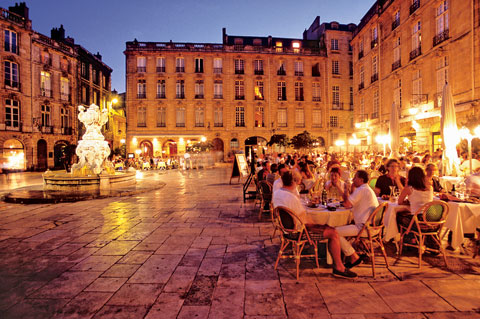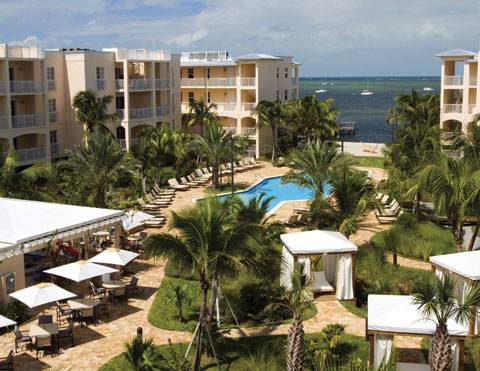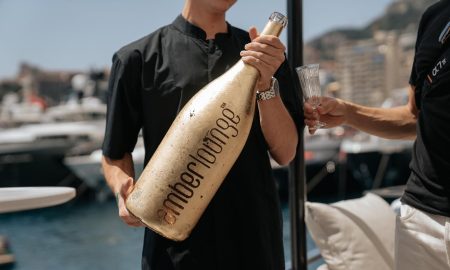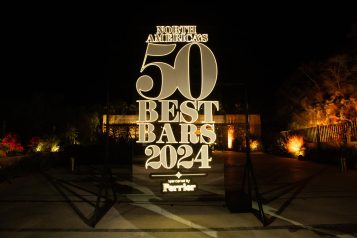Combining old-world elegance and new-world appeal, Bordeaux is fast-becoming the “IT” destination for the world’s most discerning travelers.
By Benjamin Minkus
It would be a shame to write about Bordeaux, though, without mentioning its most obvious appeal: wine.
There is the wine-the exquisite, highly-valued nectar of bacchanalians-and yet to label Bordeaux simply as a “wine town” would be unadulterated pigeonholing. For in this metropolitan port city on the river Garonne, there is a showcase of rich history, culture, and tradition. And, oh, yes, there is the world-famous wine, too.
“Take Versailles, add Antwerp, and you have Bordeaux,” acclaimed French author Victor Hugo once said. Located in the southwest of France, Bordeaux, with a population of more than one million that draws diversity (and more than 2.5 million visitors a year) from nearby Spain, Germany, Portugal, and Italy, is the capital of the Aquitaine region. The city experienced its true golden age in the 18th century, which is still prevalent through the presence of more than 5,000 downtown buildings dating back to the era. Likewise, taking a stroll down Vieux Bordeaux, one encounters grand mansions, churches, and medieval gateways.
Though much of the architecture fell into disrepair years ago, a recent surge has helped combat the buildings’ decay. “Thanks to a newfound civic pride, Bordeaux’s monuments are being scrubbed back to their original splendor,” a New York Times story said in 2006. “The cleaned up waterfront is lined with top restaurants and upscale night-life spots.” Many of the monuments, now floor-lit at night for visitors’ viewing pleasure, have been designated as World Heritage Sites by UNESCO for their tribute to major points of interest along the pilgrim road to Santiago de Compostela, the Way of St. James. Just north of the city, Jardin Public, built in 1756 and covering more than 10 hectares of land, contains cultural and archaeological attractions that would be a shame for you to miss. The park, an ideal place to picnic, holds the Museum of Natural History (one of several museums in Bordeaux), sculptures of famous French historical figures, and, most importantly, the tranquility and elegance that one would expect from such a well-manicured garden.
It would be a shame to write about Bordeaux, though, without mentioning its most obvious appeal: wine. That tradition dates to the first century AD. The Bituriges Vivisques, a Gaulish people from Burdigala (the Roman name for Bordeaux), planted Biturica vines on the banks of the Garonne. Biturica is the ancestor of today’s Cabernet, thought to be originally from Albania. The oceanic climate and soil were ideal to grow the Biturica, and thus, the city’s most identifiable roots were planted 2,000 years ago.
The Bordeaux region is the largest and oldest fine wine vineyard in the world, covering more than 115,000 hectares of vines in 57 appellations. The fanfare surrounding a fine bottle of Bordeaux easily dwarfs that of any of the finest that Napa Valley has to offer. Moreover, there are five distinct districts, each with its own unique characteristics.
Medoc, downstream from Bourdeaux, is situated on a peninsula between Gironde and the Atlantic. It has fantastic vineyard soil, and is defined in many ways by its remarkably unusual architecture. Graves, upstream from Bourdeaux, stretches from Bordeaux to Langon, along the west bank of the Garonne. Entre-deux-Mers (French for “between two waters,”) is the largest wine-growing region in Bordeaux, and is situated, logically enough, between the Garonne and the Dordogne. It also features a number of historic landmarks. The right bank, including the medieval town of Saint-Emilion, is listed as a World Heritage Site by UNESCO. Finally, the Blaye and Bourg regions overlook the Gironde estuary, and feature quaint churches, and vine-covered slopes.
There are also six wine categories, and while Bordeaux is known as the red wine capital of the world, there are two categories of white wine that the region produces, as well. Bordeaux and Bordeaux Superieur are the most common, simplest, and most fruity in taste, as well as the least expensive. Red Côtes de Bordeaux is a blend dominated by Merlot, and are slightly more sophisticated and expensive. Red Libourn (Right Bank) wines have a high ratio of Merlot to Cabernet, and include the famous Saint Emilion and Pomerol. Red Graves and Medoc (Left Bank) wines tend to favor higher concentrations of Cabernet Sauvignon, and are intended to be cellared as the character of their taste matures. White wines are broken down into dry whites and sweet whites, which are self-explanatory, though certainly worth sampling, as Bordeaux’s white wines are underrated in their superb quality. In all, the world-famous wines available in Bordeaux are copious, various, and high in quality-everything you could ever hope for.
Luckily, for those who already have Bordeaux circled as their next travel destination, getting to Bordeaux is easy enough. The city features more than 5,000 hotel rooms, including several luxurious options, and has more than 140 flights per day from cities around the world. There are more than 1,000 restaurants to choose from, where travelers can sample such delicacies as oysters from Arcachon Bay, and escargots á la caudéranaise. The best places to go to enjoy the tastes, sights, and sounds of Bordeaux are Place du Parlement, Place de la Victoire, and the Rue de Parlement Sainte Catherine-all of which offer a variety of cafés and restaurants ranging from quaint and quiet to bustling and busy. While many of the restaurants offer extremely reasonably priced food, it is still easy to find yourself paying a hefty tab thanks to some of the region’s fantastic wines.
One of the most revered restaurants in the region is Saint-James, which serves an immadulate duck foie gras and requires a reservation at least 24 hours in advance. One can certainly understand its appeal upon hearing that Saint-James is the restaurant of choice among some of the most respected vineyard owners of the region. Likewise, Dubern is highly recommended, with delicacies such as roast pigeon with truffles, while Clavel offers a succulent duck with white beans, among other options. And, as always, diners are encouraged to ask their waiter for recommendations on wine pairings-after all, a waiter from Bourdeaux might know just a little bit about the wine.
And, for the true wine connoisseur out there, there is no Bordeaux wine experience quite like the Bordeaux Wine Festival, which is held every summer. The Bordeaux Wine Festival brings the complete experience to the anxious onlooker, including vineyard tours, wine tasting, auctions, art, and free musical entertainment. What is more, the festival always offers classes to those looking for some Bordeaux education, teaching those who are interested how to appreciate wines and differentiate between their complex flavors. The most renowned names in wine-making always participate, ensuring that the Bordeaux Wine Festival is unique, but also a cut above the rest of the wine festivals around the world.
Bordeaux, though, is about more than just wine. Le Triangle d’Or is the place to be for upscale shopping, and is given its name (“The golden triangle”) because it comprises Cours de l’Intendance, Allees de Tourny, and Cours Clemenceau. And after a day of shopping, there is nothing quite like Bordeaux’s underrated nightlife scene, which centers on the Pont de Pierre Bridge. Along the banks of the Garonne, including along Le Quais, several hotspots, with their wet docks, lure in natives and tourists alike with spectacular live music, dancing, and, of course, Bordeaux wine. For a more sophisticated evening, opera and ballet are showcased at the revered Grand Théâtre on Place de la Comédie.
Of course, there is so much more to Bordeaux, a historical yet resurging city with vino roots and skyward aspirations. A city with beauty to match its rich traditions, Bordeaux should surely be your next vacation destination.
























